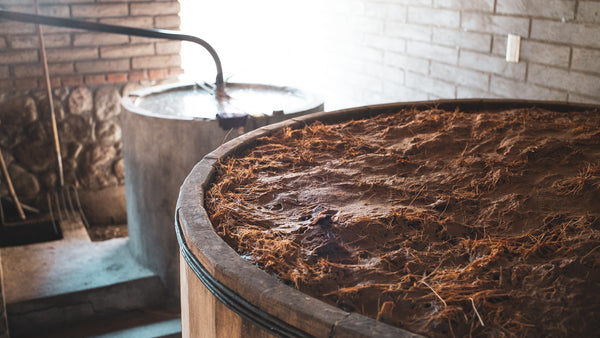Casa Cortes' International Brand Ambassador, Monica Bautista Cortes (@monimezcal) and Master Mezcalero, Francisco Javier Cortes Hernandez recently sat down in his palenque for a chat. Francisco sheds some light on the production process and remembers how far mezcal has come since he was a child. Read the full interview below.
F: My name is Francisco Javier Cortés Hernandez, this is my mezcal distillery. It’s called El As.
M: How old were you when you started producing?
F: Let's see, I started to help out my dad in 1978.
M: You were 10?
F: More or less, yeah around 10. Then in '81, when I was 12 years old, I started helping out a little more. And in ‘84-’85, I was doing it by myself. When I was around 15, I was doing the crushing, everything, I was a maestro by then.

M: Can you explain a little bit about what you do with the maguey when you plant it? How do you know when it's ready to be harvested?
F: Well, once it's 2 years old it can be planted in the fields. From there, every year it needs some upkeep. You need to clean it, have a tractor go in, so that the maguey grows well. All that maintenance is needed.
M: How do you know when to cut it? Or when it's ripe?
F: In order to be able to harvest it, the maguey needs around 9 to 10 years in order to be fully ripe. Sometimes we just know when it's good, “de sazon”, which means it's ready to be harvested, it's ready to be used for mezcal.

M: When the pencas (leaves) are cut, what do you do with those?
F: The pencas are left in the field. There are people, here in Matatlán, that take advantage of the pencas because they’re used in the kitchens, for the comales where the tortillas are made. Sometimes they’re left in the fields and later when the fields are cleaned they are burned. We only need the piña (heart of the maguey).
M: When you bring the pina here to cook, how do you know when you're ready to take it out of the oven.
F: Well when the maguey arrives at the distillery, we prepare the traditional oven. Then, we start chopping the piñas, and firewood is added to the oven, the rocks and all that. Once the rocks turn bright red, this is when the maguey is placed in the oven. After that, the maguey takes 3 to 4 days to cook. When we start crushing the maguey, we fill one vat per day. We then leave it for 3-4 days, then add cold water, then we have to mix everything in the vat (formular). When it reaches a certain point in the fermentation process, we can move on to the distillation.
M: How do you know it's ready to move from fermentation to distillation?
F: We know by listening to it, watching to see if the vat is still working (bubbling). Until it reaches a point where it stops working- that means its ready to go from the fermentation vats to the stills.

M: Does it look a certain way? You just listen to it, taste it, something like that?
F: Well, I listen to it and taste it a little to make sure it's ready to be distilled. I pay careful attention here so we get a good outcome, a good mezcal.
M: What is the most difficult in this whole process?
F: The most difficult thing is the harvesting of the maguey, cutting it and also placing the piñas in the oven. Uncovering the oven is easier, crushing and distilling steps are also better.

M: What do you like the most? Or what thrills you the most in the whole process?
F: Well I like everything, from the harvesting of the maguey, the cooking step, the uncovering of the oven. I just enjoy everything.
M: What is your view on the change in perception of mezcal, because you lived to see when it was undervalued and sold at unfair prices.
F: In 1970, which is when my dad still worked, from ‘70 to ‘77-’78, mezcal did very well. There wasn’t a shortage of mezcal and there were many producers around. But in 1982, ‘83, the demand for mezcal declined and many locals emigrated, many to Los Angeles. There was no mezcal being sold. Right now I thank God that mezcal has been selling well. Many people are exporting mezcal to other countries. I thank God there is work.
M: How do you feel about your children helping you out in this?
F: I'm happy because mezcal is being sold in other countries. My children are also happy working, and we hope this will continue. What we have to do is take care of the entire process so that this continues on. My father was a producer in the 70s, and he always told me “to produce a good mezcal, you have to take care of the maguey from the beginning. You must care take care when harvesting, crushing, and you should let it reach 9-10 years of maturity so that your final product is good." So, to date, I too am working this way- and he was right.

M: So, coming from a line of several generations of mezcaleros, what would you like to say to people who are just learning about mezcal, or what would you like them to know about mezcal?
F: As a mezcal producer, with my experience, I encourage all producers who are currently producing or who are starting to produce, that we take care of our work. We should strive to distill a good mezcal so that Matatlán continues to have a good reputation, that is what all mezcal producers must do. We must aim to preserve that, work well, and take care of all that process, so that mezcal doesn't change.
Dixeebe!!



Dejar un comentario